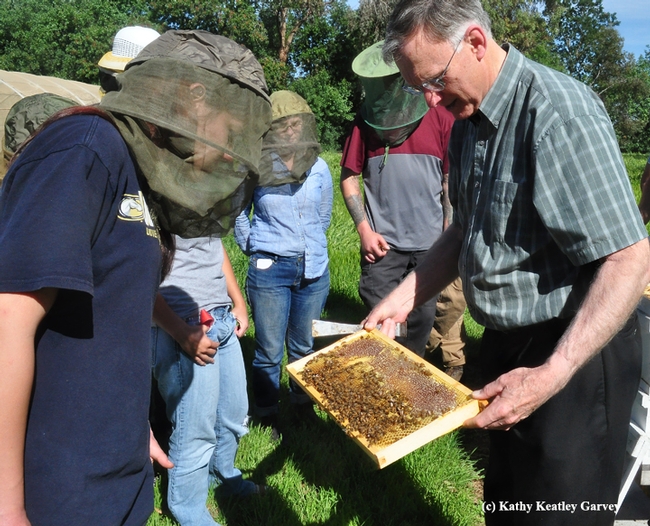
And it's an enemy to be reckoned with, Extension apiculturist Eric Mussen told students in the UC Davis "Biology of Parasitism" class, taught by forensic entomologist Robert Kimsey and nematologist Steve Nadler, Department of Entomology and Nematology.
Guest-lecturing at a special session held at the Harry H. Laidlaw Jr. Honey Bee Research Facility, UC Davis, Mussen talked about the varroa mite--its history, biology, damage and control methods--and then opened several hives at the apiary.
The Varroa destructor, a native of Asia, is now found in hives throughout the world except in Australia. It was first detected in the United States in 1987.
The eight-legged reddish-brown parasite, about 1–1.8 mm long and 1.5–2 mm wide, is a blood sucker that's difficult to control, Mussen said. Mites transmit viruses (there are now some 22 named RNA viruses) that can wipe out a hive. A familiar mite-transmitted disease that beekeepers see is DWV or Deformed Wing Virus. Mites are also known lowering the protein level of a bee's blood, and reducing its weight and life span.
Mussen said that mites spread from colony to colony by phoresy (animal-to-animal transport). They ride on flying drones (males) and adult worker bees (females). They also spread changing hosts on flowers.
"A mite enters a honey bee cell just before or during the time it is being capped," Mussen said. "It feeds on older larva or prepupa. Sixty hours later, the mite lays its first egg. The egg will hatch in about 24 hours."
"The number and release of offspring depend on the length of the pupal stage. The queen is pupa for 8.5 days (no mites). The worker is pupa for 12.5 days (1.3 mites) and the drone is pupa for 14.7 days (3 or 4 mites)," he said. Thus, due to the longer time required for drone development, drone pupae get the worst of it.
"When maturing, the newly emerged mites climb onto adult bees and feed by puncturing the intersegmental membranes and sucking the bee blood," Mussen related. "Often these are nurse bees that stay around the brood nest. Sometimes the hosts are drones and older foragers that are flying from the hive every day. Eventually the new mite climbs off the nurse bee onto a comb in the brood nest and enters a cell. The reproductive cycle starts and within 6 days, 44 percent of the young mites have moved into the brood cells; within 12 days, 69 percent of the mites are in the brood cells; and within 24 days, 90 percent of the mite are in the brood cells."
"If there is no brood, the mite has to feed on adult bee blood every six days or so to remain alive," Mussen said. "Mite life expectancy in summer is around 60 days; bees about 42 days. Mite life expectancy in the winter is up to 9 months; bees about six months."
Mussen also discussed how to detect mite infestations through non-chemical and chemical methods, and listed chemical treatments being used throughout the nation. Mites are developing resistance to a few chemical treatments, he pointed out. And, some of the chemical treatments not only kill the mites, but damage or kill the queen and the brood.
Beekeepers who try to go organic, figuring that "if the bees can't make it on their own--if they're not fit--let them die" are really doing a disservice to neighboring beekeepers, Mussen said. The mite will overrun a colony and then infest other colonies.
Public Enemy No. 1--definitely a force to be reckoned with.
Attached Images:

Extension apiculturist Eric Mussen (second from left) talks to a UC Davis class in the apiary of the Harry H. Laidlaw Jr. Honey Bee Research Facility. Third from left is forensic entomologist Robert Kimsey, one of the two class instructors.(Photo by Kathy Keatley Garvey)

Extension apiculturist Eric Mussen shows a frame to the students. (Photo by Kathy Keatley Garvey)

Varroa mites are reddish brown. (Photo by Kathy Keatley Garvey)

Extension apiculturist Eric Mussen reaches for a smoker as a bee (far left) buzzes off. (Photo by Kathy Keatley Garvey)